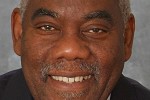By Dr Selwyn R. Cudjoe
December 25, 2018
 On Sunday last, the Lydian Singers’ concert, “The Gift,” explored “the gifts of Gold, Frankincense, Myrrh…and Music” at its final concert at Queen’s Hall Auditorium. There were many outstanding performances. I was enthralled by Pat Bishop’s practice of blending local and foreign elements and her insistence that our musical forms can achieve standards of excellence that occur in other societies.
On Sunday last, the Lydian Singers’ concert, “The Gift,” explored “the gifts of Gold, Frankincense, Myrrh…and Music” at its final concert at Queen’s Hall Auditorium. There were many outstanding performances. I was enthralled by Pat Bishop’s practice of blending local and foreign elements and her insistence that our musical forms can achieve standards of excellence that occur in other societies.
The explosion of the tassa drums, steelband music, and ethereal voices that came together joyously in Handel’s “Hallelujah Chorus” provided a fitting climax to a scintillating and inspiring evening. Written by Handel as he faced the prospect of being placed in a debtor’s prison, he could do nothing but summon the majesty of our Lord and Savior to comfort him in his hour of need.
As I experienced this performance, I thought of a related performance of Jamaica’s National Dance Company under the direction of the late Rex Nettleford that I saw at the same venue many years ago. Years later, I experienced the dramatic presentation of Derek Walcott’s Joker of Saville, at Boston Playwrights’ Theater that Walcott founded when he joined the Boston University faculty in 1981.
The performances of Nettleford and Walcott were acts of beauty. They were the closest things to artistic perfection. That combination of dance, music, song and poetry, reminded me of the texture of Caribbean life that was forged in bondage, resistance and hope. Like Walcott’s work, Nettleford and Bishop’s artistic productions were “of great luminosity, sustained by a historical vision, the outcome of a multicultural commitment” (Nobel Literature Committee).
Bishop’s work arises out of a similar cultural milieu. Her magnificent crocheting of our classical music (the steelband) with those of acclaimed European composers allowed her musical director, Lorraine Granderson, to stamp her indelible mark upon Bishop’s work. Recognizing the foundational role that calypso music has played in the making of our people, Granderson and the Lydian Singers offered her concert “as a tribute to all fallen Kaisonians.”
This cultural integration should not be wondered at. Calypsonians played their part in localizing our culture, commenting on each aspect of our people’s business. In appropriating our people’s business and making it their own, they embody that peculiar capacity to send back to a people a sense of their identity. As Ox (Lester Wilshire), a Tacarigua philosopher once said: “The people’s business is our business. Without the people’s business, we are out of business. Therefore, we need to know the people’s business to exist.”
Gossip and fact, the innovative manipulation of the word, or the nommo, as the West African philosophers assure us, were central to constructing the African sensibility. In our case, the blending of our oral traditions (the ramleela, the hosay chants at the death of Husayn and Hassan), and the gut-wrenching truths of our calypsonian are central to our existence. They always remind us to keep our feet to the ground.
Bishop, Walcott and Nettleford are the products of a sensibility, a rhythm and a way of seeing that was created in the West Indies. It was appropriate therefore that after Bishop received her first degree in art from the University of Durham, England, she traveled to UWI (Mona, Jamaica) to do graduate studies in West Indian history. Appropriately enough, her master’s thesis was “The Runaway Slaves of Jamaica, 1807-1823.”
Bishop’s musical trajectory and the Lydian Singers which she developed—the group was formed by Joyce Spence of Bishop’s Anstey High School—stuck their creative feet into the fertile soil of a tradition that was waiting to be explored, expressed and ritualized. Sunday’s concertgoers went to Queen’s Hall to pay their respect to a profound dimension of our being. In honoring what is uniquely ours, they were paying respect to the El Tucuche of our aspirations (a phrase of LeRoy Clarke), the sacred mountain in Amerindian folklore.
In the same way the Jamaica National Dance Company and Walcott’s Boston Playwrights showcased our ability to produce art, dance, and song and poetry at the highest level of perfection, the Lydian Singers took me into that zone of international perfection. When Joanne Pyle rendered “O Holy Night,” Edward Cumberbatch sang “Sweet and Low” and Germaine Wilson delivered “Tu che di gel sei cinta,” an aria from the opera Turandot, I was swept away by the joyousness of Christmas and the ineluctable beauty of our people.
“The Gift” ended with Handel’s “Hallelujah Chorus” as the tassa drums rang out infectiously in accompaniment. Central to the Shiite’s religious tradition, the hosay celebrations have become a part of our dramatic repertoire. In Muslim theology Jesus is seen as “a brother of Husayn, the slain martyr of the Muslim religion, a saint whom the Muslim commemorates in the hosay festival” (Cudjoe, Beyond Boundaries).
Many beautiful things happen in Trinidad and Tobago. All is not madness and mayhem. Therefore, it behooves us all to spread the word of our beauty and our truth and the many exciting things that are happening in our country. We are made by our words, our deeds and our actions. It is important to always say a good word about our country.
In Trinidad and Tobago one can experience this innovative commingling of religious and secular forms. That is the real gift that the Lydian Singers gave us this Christmas.
